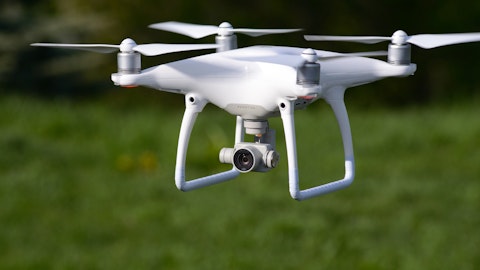Acuity Brands, Inc. (NYSE:AYI) Q1 2024 Earnings Call Transcript January 9, 2024
Acuity Brands, Inc. beats earnings expectations. Reported EPS is $3.72, expectations were $3.09. AYI isn’t one of the 30 most popular stocks among hedge funds at the end of the third quarter (see the details here).
Operator: Good morning, and welcome to the Acuity Brands Fiscal 2024 First Quarter Earnings Call. At this time, all participants are in a listen-only mode. After the speaker’s presentation, the company will conduct a question-and-answer session. Please be advised that today’s conference is being recorded. I would now like to hand the conference over to Charlotte McLaughlin, Vice President of Investor Relations. Charlotte, please go ahead.
Charlotte McLaughlin: Thank you. Good morning, and welcome to the Acuity Brands fiscal 2024 first quarter earnings call. As a reminder, some of our comments today may be forward-looking statements based on our management’s beliefs and assumptions and information currently available to our management at this time. These beliefs are subject to known and unknown risks and uncertainties, many of which may be beyond our control, including those detailed in our periodic SEC filings. Please note that our company’s actual results may differ materially from those anticipated, and we undertake no obligation to update these statements. Reconciliations of certain non-GAAP financial metrics with our corresponding GAAP measures are available in our 2024 first quarter earnings release, which is available on our Investor Relations website at www.investors.acuitybrands.com.
With me this morning is Neil Ashe, our Chairman, President and Chief Executive Officer, who will provide an update on our strategy and give an overview of the quarter. And Karen Holcom, our Senior Vice President and Chief Financial Officer, who will walk us through our fiscal first quarter financial performance. There will be an opportunity for Q&A at the end of this call. For those participating, please limit your remarks to one question and one follow-up, if necessary. We are webcasting today’s conference call live. Thank you for your interest in Acuity Brands. I will now turn the call over to Neil Ashe.
Neil M. Ashe: Thank you, Charlotte and thanks to all of you for joining us this morning. We continue to demonstrate strong execution in our fiscal 2024 first quarter. We increased our adjusted operating profit, our adjusted operating profit margin, and our adjusted diluted earnings per share. We generated significant free cash flow and we allocated capital effectively to drive value. Both our Lighting and our Intelligent Spaces businesses continued to perform well during the quarter. Particularly in ABL our performance was excellent. We increased adjusted operating profit by $15 million on $71 million less sales, and increased the adjusted operating profit margin 280 basis points to 17.5%. Our strategy is yielding results. We’re increasing product vitality, elevating service levels, using technology to improve and differentiate both our products and how we operate the business, and we are driving productivity.
Today, our products are perceived as being more valuable in the marketplace at the same time, we are lowering costs. Our product vitality efforts are the combination of new product introductions and improvements to our existing portfolio to ensure that our products are more valuable to our customers and more profitable for us. Our Contractor Select portfolio is about 300 of our most popular products. They are used in common everyday lighting applications and are in stock at retailers and electrical distributors. We continue to invest in product vitality and we have expanded our Lithonia Lighting ESXF floodlight family. This is a better product for distributors because it allows them to carry less inventory and is better for contractors because it is easier to install.
This product family was first introduced in 2022 to offer a uniform lighting solution for parking lots, walkways, and outer buildings. It uses switchable technology to provide installers 36 on site options, including lumen output, color temperature, photocell, and mounting options. Our Design Select portfolio consists of configurable product options that meet the key choices of lighting specifiers with high levels of service. This quarter, we added additional products in our down lighting, panel, emergency lighting, and outdoor categories. As we expand the options available in this portfolio, our focus is on product vitality and making it easier for the specification community to choose superior solutions. Our efforts to elevate service are having a positive impact on our customers.
In October, we were once again recognized by the voters of IMARK Electrical as one of the suppliers of the year for 2023. We also continue to invest in productivity improvements in our operations. Earlier this quarter, we traveled with a group of associates to our Mexican manufacturing facilities to open our new state of the art Santa Rosa production facility, which includes our highly efficient new paint line. This facility embraces technology to deliver a better product to our customers and improves the efficiency of the paint line process, while also reducing the environmental impact. I’d like to highlight a couple of ways we’re doing this. Our paint guns and torque guns in our new facility are powered by a high efficiency air compressor that aims to reduce approximately half of our CO2 generation compared to the air compressor from our previous paint line.
High efficiency walls, burners, and booster technology in our ovens require less gas than similar systems and use around 40% less natural gas than our previous infrared ovens. The transition to this facility has been seamless. We relocated an existing facility to the new SPF facility without any service interruption, and now have capacity available for future growth. Our combined paint and natural gas savings are delivering on our required financial return for the facility, while also meeting our sustainability objectives. You can learn more about this project and other accomplishments in our recently released Earth Light Report, valuable on our ESG for investors page on our Investor Relations website. Now moving to our Spaces Group. Our mission in our intelligent spaces business is to make spaces smarter, safer, and greener through a strategy of connecting the edge to the cloud.

This tech has the best edge control devices on the market, while Atrius will be the best in cloud applications. At Distech, we are focused on expanding our addressable market in two ways. The first is geographic, and the second is increasing what we control in a built space. This quarter, we continued our geographic expansion, adding several new system integrators in the UK, Asia and Australia. In one of our original markets, France our hard work is paying off. The Building Services, Research and Information Association called out Distech as dominating the French building, automation, and control systems market in a newly released report. We also continue to increase what we can control in a build space. In October, we launched our Distech Reset [ph] Move Sensor at several industry conferences in Europe.
This is an advanced 7 in 1 ceiling mounted sensor that is able to detect occupancy in spaces. It counts the number of people using a space, providing feedback on occupancy requirements to the building users. It is AI powered and can be used to optimize indoor air quality, reduce energy and cleaning costs, and enhance occupancy comfort. It will be revealed to our North American and international customers at the AAHR Expo in Chicago later this month. Our expansion into refrigeration controls is also going well with the integration of KE2 Therm on track and performing as we expect it. During the quarter, we released the KE2 Therm Edge manager with a back net communication stack. This is the same open protocol technology that is used by Distech, and is an important step to ensure compatibility between both the Distech edge controllers and the KE2 Therm edge controllers.
Now turning to our outlook. The changes that we have made to the business are impactful and long lasting. Our order rates are growing both year-over-year and sequentially. We’re back to typical lead times, and absent the excess backlog from last year, we would be experiencing sales growth. We are focused on controlling what we can control, and we are confident our execution will continue. In our Lighting and Lighting Controls business, we will continue to focus on delivering margin and cash flow. In our Spaces Group, we will continue to grow geographically and by adding to what we can control in a build space. We’re delivering applications that are making a difference. Now I’ll turn the call over to Karen, who will update you on our first quarter performance.
Karen J. Holcom: Thank you Neil and good morning to everyone on the call. We started the year with strong performance. We increased our adjusted operating profit by $14 million year-over-year, improved our adjusted operating profit margin by 250 basis points over the prior year, and by 40 basis points sequentially. We increased our adjusted diluted earnings per share by $0.43 year-over-year and generated cash flow from operations of $190 million. We continue to improve our businesses and allocated capital effectively. For total AYI, we generated net sales in the first quarter of $935 million, which was $63 million or 6% lower than the prior year as a result of the lower net sales in our ABL business. This was partially offset by continued growth in the ISG business of 13% in the quarter.
We continue to deliver year-over-year margin improvement. During the quarter, our adjusted operating profit increased by $14 million on lower sales, while we expanded adjusted operating profit margin to 16.5%, an increase of approximately 250 basis points from the prior year. This increase was driven largely by the significant year-over-year improvement in our gross profit margin as we continued to execute and drive margin through product vitality, the management of price and cost, and productivity improvements. During the quarter, our adjusted diluted earnings per share of $3.72 increased $0.43 or 13% over the prior year, primarily as a result of higher net income and to a lesser extent, lower shares outstanding due to the share repurchases.
In ABL, net sales were $876 million in the quarter, a decrease of around 7% compared with the prior year, driven by declines across most of our channels, offset slightly by continued strong performance in our retail channel. Sales growth in ABL this quarter had a challenging year-over-year comparison as the results in the first quarter of fiscal 2023 benefited from working down an elevated level of backlog. ABL’s adjusted operating profit increased 11% to $154 million on lower net sales and we delivered adjusted operating profit margin of 17.5%, a 280 basis point improvement over the prior year. ISG’s net sales for the first quarter were $64 million, an increase of 13% as Distech continued to grow and KE2 Therm performed as we expected. ISG’s adjusted operating profit was $10 million.
Now turning to our cash flow performance. We generated $190 million of cash flow from operating activities for the first quarter of fiscal 2024, an increase of $3 million over the prior year, primarily due to an improvement in net income partially offset by a decrease in cash flow from working capital. During the first quarter of fiscal 2024, we continued to allocate capital consistent with our priorities. We invested $15 million in capital expenditures and allocated approximately $50 million to repurchase around 300,000 shares. Since the beginning of the fourth quarter of fiscal 2020, we have repurchased over 9 million shares at an average price of about $143 per share, which was funded by organic cash flow. To wrap up, we had a strong quarter, particularly in ABL.
We continued to deliver strong margin and cash flow performance. We grew adjusted operating profit and improved adjusted operating profit margin. We increased adjusted diluted earnings per share, generated strong cash flow from operations, and allocated capital effectively. We are pleased with our performance, and we will reevaluate the outlook at the midpoint of the year. Thank you for joining us today. I will now pass you over to the operator to take your questions.
Operator: Thank you. [Operator Instructions]. Our first question comes from the line of Joe O’Dea with Wells Fargo. Your line is now open.
See also 12 Best Solar Power Stocks To Invest In According to Financial Media and Chamath Palihapitiya Stocks: 12 Stocks Pumped in the Last 10 Years.
Q&A Session
Follow Acuity Brands Inc (NYSE:AYI)
Follow Acuity Brands Inc (NYSE:AYI)
Joseph O’Dea: Hi, good morning. Can you hear me?
Neil M. Ashe: Yeah, good morning Jeff.
Joseph O’Dea: Hi. So — I mean, really impressive gross margin obviously this quarter. I think just any additional detail unpacking that, you talked kind of high level on vitality, productivity, price cost. But anything in terms of kind of quantifying that bridge when we think about sequentially gross profit down kind of less than what we saw out of the revenue decline and trying to appreciate sort of what some of the moving pieces are there and then bigger picture just the sustainability of a 45.8% gross margin?
Neil M. Ashe: Yes. Thank you, Joe. Good morning to all of you. So, as we unpack the margin performance, a couple of things to talk about. First of all, obviously, our year is off to a really good start. We’re taking the companies to levels of performance that it has never seen before and these margins are the result of the impacts of the strategy and the work that our team has been doing to implement that, around product vitality, around service, around technology, and around productivity that has culminated in this performance. Specifically, in this quarter we’re recognizing that our products, as I said in the prepared remarks, are being valued for their impact in the marketplace, which affords us the opportunity to manage price strategically.
We continue to take cost out of the production of the products so the output is the margin that you see. This quarter was mildly impacted by some mix. The — our controls business was strong, our ISG is obviously growth accretive, margin accretive, and return accretive so that has some impact. But when you boil it all down, this quarter is a result and the margin performance in this quarter is a result of the strategy and the work that we’ve been doing around product vitality, around service, around technology, and around productivity.
Joseph O’Dea: And just a quick clarification because you did make the point in prepared remarks and just kind of reiterated it there, where product is perceived as more valuable in the marketplace today. I thought about sort of the pricing dynamic over the last couple of years as being priced in response to cost. But is it fair to sort of deduce that this quarter you’re actually in the market sort of taking price up because it’s the value that you’re delivering, and so you’re still able to achieve price up?
Neil M. Ashe: So we — I believe that’s a fair conclusion. Yes, we are realizing the benefits in the first quarter of price. We talked about in the last call and in the second quarter, we also implemented a price increase. So we’re demonstrating to the market that we will continue to manage price. So — that’s obviously in the second quarter, so has no impact on these numbers. But as I’ve said consistently, we’re moving to strategically manage price. And by that, we mean that, number one, our products need to be valued in the marketplace because they need to deserve to be valued. We’re in a good position on that front. The second around our product vitality efforts is that we need to demonstrate that we can make more money with profit as a result of those prices, which is what we’re doing from a cost perspective.
So I believe this is a good foundation. Now obviously, these are extraordinary margins so we don’t need to continue to perform at this level for the rest of the year but to deliver outstanding results. But we feel very good about the how in these margins.
Joseph O’Dea: I appreciate it, thanks very much.
Operator: Thank you. Our next question comes from the line of Tim Wojs with Baird. Your line is open.
Timothy Wojs: Hey everybody, good morning.
Neil M. Ashe: Hey, good morning Tim.
Timothy Wojs: Maybe just my first question, Neil, you had kind of talked about in the prepared remarks that order rate has kind of improved sequentially and that they’re up year-over-year. I know it’s probably hard, but I’ll ask the question anyway. I mean, how much of that do you think is just the year-over-year comparisons kind of lapping some of the backlog depletion and a lead time improvement versus maybe what’s going on in the underlying end market?
Neil M. Ashe: Yes, thanks for the question, Tim. Let me unpack that because I think this is really important. So — so our net sales is obviously a result of our shipments in the period. The shipments in the period are a result of the orders that led up to at times the lead time basically. So we are now in a position where our lead times have more normalized. In other words, the order and the shipment rates are relatively consistent with each other and so it’s important that on both a sequential basis and on a year-over-year basis our order rates are modestly up. In other words, without last year’s comparable sales would be growing. Last year was the net sales were the beneficiary of backlog reduction from orders which had been placed earlier.
So the order — when we talk about this order rate being up modestly, that’s versus the daily order rate of last year’s first quarter and last year’s fourth quarter. So, the best way that we’ve come to think about this is that there was more of a pull forward last year industry-wide than there was a cycle. So in effect we processed a lot more business last year that existed. When you smooth the line over time, and we’ve talked about this consistently, when you smooth the line over time, we will be — the Lighting and Lighting Control business will be a consistent grower.





